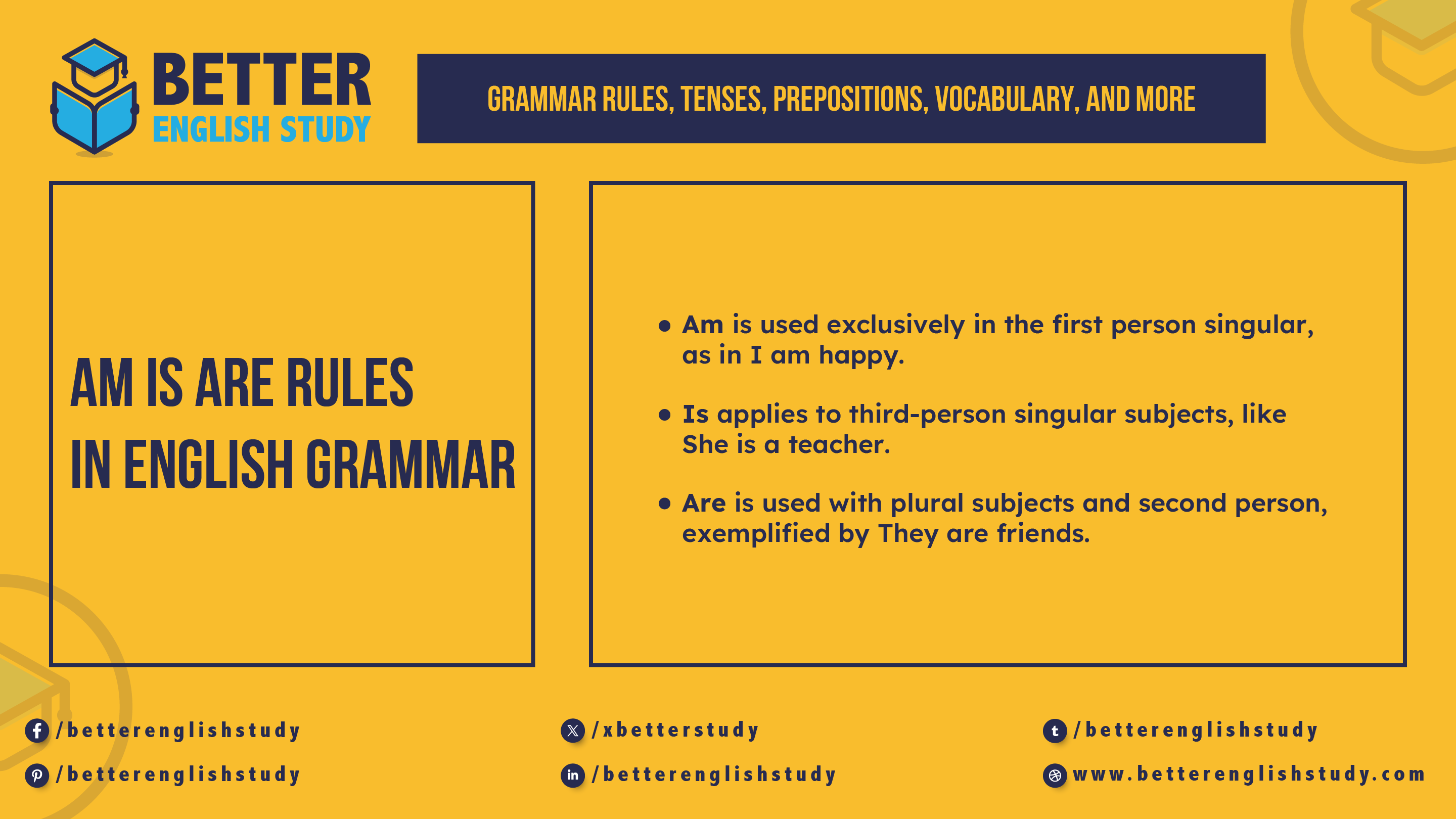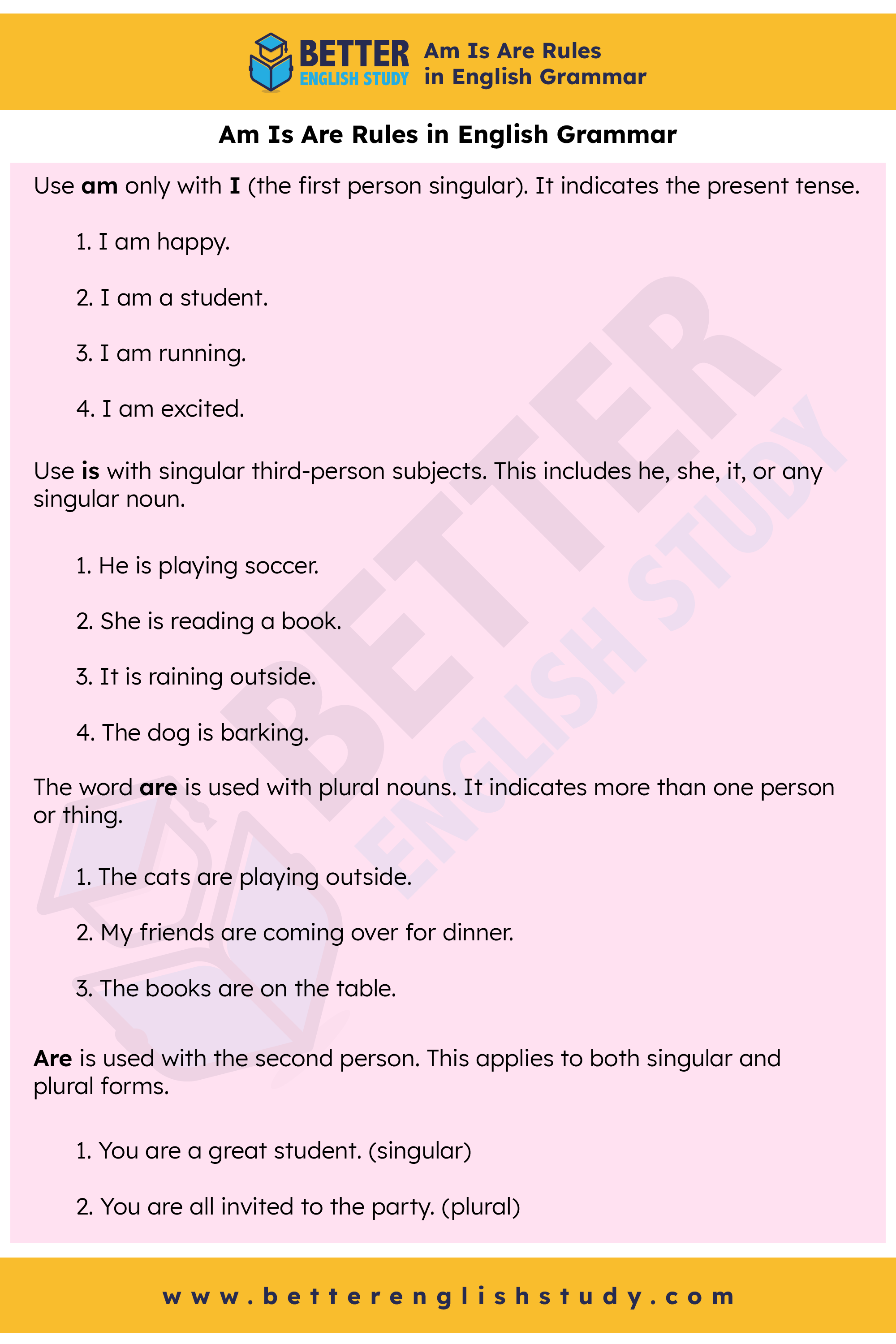
“Am,” “is,” and “are” are forms of the verb “to be.” Use “am” with “I,” “is” with singular nouns, and “are” with plural nouns.
Understanding the verb “to be” is essential for mastering English grammar. It serves as a linking verb, connecting the subject to its complement.
“Am” is used exclusively in the first person singular, as in “I am happy. “
“Is” applies to third-person singular subjects, like “She is a teacher.”
“Are” is used with plural subjects and second person, exemplified by “They are friends. ”
Mastering these forms helps in crafting clear and concise sentences. Correct usage enhances your communication skills, making it easier for others to understand your message. Knowing these rules can significantly improve your writing and speaking abilities.
Introduction To ‘am’, ‘is’, ‘are’
Understanding the verbs ‘am’, ‘is’, and ‘are’ is key in English. These verbs are forms of the verb ‘to be’. They help form sentences about identity, state, or condition. Knowing how to use them correctly makes communication clearer.
The Basics Of ‘Be’ Verbs
The verbs ‘am’, ‘is’, and ‘are’ are essential in English. They serve different purposes based on the subject.
| Verb | Subject | Example |
|---|---|---|
| Am | I | I am happy. |
| Is | He/She/It | She is a teacher. |
| Are | You/We/They | They are friends. |
Importance In English Grammar
Using ‘am’, ‘is’, and ‘are’ correctly is crucial. These verbs help express:
- Identity: Who someone is.
- State: How someone feels.
- Condition: What something is like.
Incorrect use can change the meaning of sentences. For example:
- I am a student.
- He is tired.
- They are happy.
Mastering these verbs makes speaking and writing easier. Practice using them daily for improvement.
Understanding ‘am’
The verb ‘am’ is a key part of English grammar. It is the first person singular form of the verb ‘to be’. You use it with the pronoun ‘I’. Understanding its usage helps in forming correct sentences.
Usage With The First Person Singular
Use ‘am’ only with ‘I’. It indicates the present tense. Here are some rules:
- ‘Am’ shows identity.
- ‘Am’ indicates state or condition.
- ‘Am’ expresses ongoing actions.
Examples In Sentences
Here are simple examples of ‘am’ in sentences:
| Sentence | Explanation |
|---|---|
| I am happy. | This shows a feeling. |
| I am a student. | This states identity. |
| I am running. | This shows an ongoing action. |
| I am excited. | This expresses a current emotion. |
Using ‘am’ correctly helps in clear communication. Practice these examples to become confident.

The Use Of ‘is’
The word ‘is’ is a vital part of English grammar. It acts as a linking verb. It connects the subject with more information. Understanding its use helps in forming correct sentences.
When To Use With Singular Third Person
Use ‘is’ with singular third-person subjects. This includes he, she, it, or any singular noun. Here are some clear rules:
- He is a teacher.
- She is my friend.
- It is a sunny day.
- The cat is sleeping.
In these examples, ‘is’ connects the subject to its description.
Illustrative Examples
| Subject | Example Sentence |
|---|---|
| He | He is playing soccer. |
| She | She is reading a book. |
| It | It is raining outside. |
| The dog | The dog is barking. |
Each sentence uses ‘is’ to describe actions or states.
Using ‘is’ correctly makes your sentences clear. This helps in effective communication. Practice using it with various subjects.
Employing ‘are’ Correctly
Using the word ‘are’ correctly can enhance your English skills. This verb is essential for forming sentences about multiple subjects. It shows a connection between the subject and the action or state of being.
Application With Plural Subjects
The word ‘are’ is used with plural nouns. It indicates more than one person or thing. Here are some examples:
- The cats are playing outside.
- My friends are coming over for dinner.
- The books are on the table.
In each example, ‘are’ connects the subject to the action. Always remember to use ‘are’ with plural subjects.
Second-Person Singular And Plural Usage
In English, ‘are’ is used with the second person. This applies to both singular and plural forms. Here’s how it works:
- You are a great student. (singular)
- You are all invited to the party. (plural)
In both cases, the subject ‘you’ requires ‘are’. It shows that the action applies to the person or group being addressed.
Examples To Clarify
Here are more examples to reinforce the use of ‘are’:
| Subject | Verb | Complete Sentence |
|---|---|---|
| Dogs | are | The dogs are barking loudly. |
| Children | are | The children are playing in the park. |
| You | are | You are very talented. |
These examples show the correct use of ‘are’ with plural subjects and the second person. Use them as a guide in your writing.
Common Mistakes And Corrections
Understanding the correct usage of am, is, and are can be tricky. Many people mix them up. Learning these common mistakes helps improve your grammar skills. This section highlights frequent errors and how to correct them.
Mixing Up ‘am’, ‘is’, ‘are’
It’s easy to confuse am, is, and are. Here’s a simple guide:
| Subject | Correct Form |
|---|---|
| I | am |
| He/She/It | is |
| You/We/They | are |
Examples:
- I am happy.
- She is a doctor.
- They are friends.
Correcting Frequent Errors
Here are some common mistakes and their corrections:
- Incorrect: He are a teacher.
- Correct: He is a teacher.
- Incorrect: We is going to the park.
- Correct: We are going to the park.
- Incorrect: I is excited.
- Correct: I am excited.
Use these tips to improve your grammar. Practice makes perfect!
Interactive Exercises
Practice makes perfect. Engage with these exercises to master the verbs am, is, and are. They will help you gain confidence in using these important verbs correctly. Let’s dive into two fun activities!
Fill-in-the-blank
Complete the sentences using am, is, or are. Choose wisely!
- She ___ my best friend.
- They ___ going to the park.
- I ___ excited about the trip.
- The cat ___ on the roof.
- We ___ learning English.
Sentence Correction
Find and correct the mistakes in these sentences. Use am, is, or are correctly!
- I is happy today.
- He are my brother.
- They am playing football.
- She are a good student.
- We is going to the movies.
After correcting the sentences, your skills will shine! Keep practicing to improve.
Advanced Usage
Understanding the advanced usage of “am,” “is,” and “are” is essential. These verbs help form different types of sentences. They can change meaning based on structure. Let’s dive deeper into questions, negative sentences, and contractions.
Questions And Negative Sentences
Creating questions or negative sentences often requires a change in structure. Here’s how to do it:
- Questions: Start with the verb.
- Negative Sentences: Add “not” after the verb.
Here are some examples:
| Type | Example |
|---|---|
| Question | Are you ready for the test? |
| Negative Sentence | I am not hungry. |
| Question | Is she your friend? |
| Negative Sentence | He is not coming to the party. |
Use this structure to form clear questions and negatives. Remember to adjust the tone based on your audience.
Contractions With ‘am’, ‘is’, ‘are’
Contractions make speech and writing more natural. Here are the common contractions:
- I’m = I am
- He’s = He is
- She’s = She is
- It’s = It is
- We’re = We are
- They’re = They are
Here are some examples:
| Full Form | Contraction |
|---|---|
| I am going to school. | I’m going to school. |
| She is my sister. | She’s my sister. |
| They are playing outside. | They’re playing outside. |
Using contractions makes communication smoother. It’s common in spoken English. Use them to sound more casual.
Practical Tips For Mastery
Mastering the use of “am,” “is,” and “are” improves your English skills. Here are some effective tips for daily practice and useful resources.
Daily Practice Routines
Daily practice helps reinforce your understanding. Here are some easy routines:
- Flashcards: Create flashcards with different subjects. Write sentences using “am,” “is,” and “are.”
- Sentence creation: Write ten sentences daily. Use all three verbs.
- Online quizzes: Take quizzes focused on “am,” “is,” and “are.” Websites like Quizlet offer great options.
- Speaking practice: Talk to a friend or record yourself. Use sentences with “am,” “is,” and “are.”
Frequently Asked Questions
What Are The Uses Of “am,” “is,” And “are”?
“Am,” “is,” and “are” are forms of the verb “to be. ” They indicate the state or condition of a subject. “Am” is used with “I,” “is” with singular subjects, and “are” with plural subjects. Understanding these rules helps in forming correct sentences in English.
How Do I Use “am” Correctly In Sentences?
“Am” is used exclusively with the subject “I. ” For example, “I am learning English. ” It indicates the present tense and shows a current state or action. Remember, it cannot be used with any other subjects. This makes it straightforward to apply in everyday conversation.
When Should I Use “is” In A Sentence?
Use “is” with singular nouns or third-person subjects. For instance, “She is a teacher” or “The cat is sleeping. ” It describes a current state or action. Understanding the subject-verb agreement is crucial to using “is” correctly in English grammar.
What Is The Rule For Using “are”?
“Are” is used with plural subjects and the second-person “you. ” For example, “They are friends” or “You are welcome. ” It signifies the present tense and is essential for accurate sentence construction. Knowing this helps avoid common grammar mistakes in writing and speaking.
Conclusion
Mastering the rules of “am,” “is,” and “are” is essential for clear communication in English. These verbs are fundamental to constructing sentences correctly. With practice and examples, you can easily improve your grammar skills. Keep revisiting these rules to enhance your writing and speaking abilities.
Remember, clarity is key!
